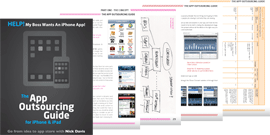Understand what you want to achieve
… but also understand who your audience is and what they want.
Work with limitations, maximise benefits
Understand that you are producing an iPhone or iPad app and this involves certain limitations (some imposed on you by technology, some by Apple’s policies) but that these can be used to your advantage to integrate your app better with the rest of the device and ultimately create a better user experience. Also understand that gestures are very much a part of creating a great app and have quickly become part of user’s expectations (watch someone picking up a non-Apple device and instinctively tr ying (and failing) to use gestures). Make sure then, you are familiar with what can be done and these are included (wherever appropriate) from the start of your plans.
Live together, die alone
If you are doing this for your employer do involve other parties as early as possible (design, editorial, sales, marketing, the directors, your sponsors). Get their ideas and get their buy-in.
Research (and then research some more)
Research other apps, looking at everything they do well. Pay particular attention also, to what their users complain about or praise them for in the User Reviews part of their page on the App Store.
Don’t hide from the competition
If you are aiming to do better than a particular competitor’s app, ask yourself: In what ways can I make my app better? More user friendly? Better marketed (more on this in Part Four)?
Think about monetisation
Think about monetisation now. If sponsorship and/or advertising is likely, try to incorporate this into your page layouts, designs and specs from day one.Trying to force it in later is usually a recipe for a mess.
Future-proofing (or some corners aren’t worth cutting)
‘Can we just change this logo/text before tomorrow morning?’ If these are words you are likely to hear after the launch of the app then you’d better have a plan.Whether you end up deciding you are happy to do an app update for each major change, or your app simply has to be able to be updated remotely, just make sure any colleagues or sponsors involved understand the implications.
Keep expectations down (to a reasonable level)
I don’t mean to sound un-ambitious – and as cool as some apps can be – if you’re producing an app for your employer it is important to keep the expectations of your boss, directors, co-workers down to a sensible level. That definitely includes the time it might take Apple to approve it and the possibility (though very low for your project I’m sure) of it being rejected at first.
Do register your Apple account in plenty of time, preferably several weeks before you plan to submit
Fast forward a few weeks. App all set-up? About to press go? You are about to send your pride and joy to Apple and then realise you don’t have a developer account yet. Unfor tunately getting an account can take a few weeks too depending on the type of company and it’s location.You may wait a week to hear from Apple, only to then be requested to fax (no emails, just fax) some important company documents and wait some more. Chances are you will be approved without any issue but in the meantime you will have no app in the App Store.
Plan plan plan then run with it
Don’t be afraid to really spec out every detail of the app. Firstly, you are kidding yourself if you think you can keep all this stuff in your head. Secondly, it doesn’t have to be hard work (use the templates provided in this guide) and it will actually make the rest of the process of creating the app easier. Thirdly, as ever – and particularly with technology – assumptions kill. If you think you know what should happen when a user presses a particular button make sure everyone else does too. Once you have that all down and agreed though, don’t sit and procrastinate on it – get things moving!
